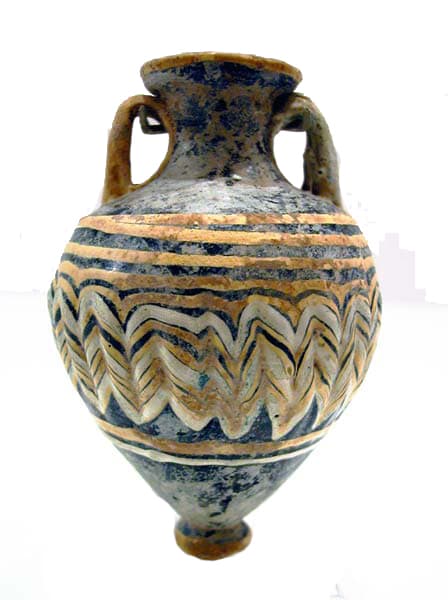Sand-Core Formed Glass Amphoriskos, 6 Century BCE - 5th Century BCE
Glass
1.75 x 2.75
X.0618
Further images
This fifth to fourth century B.C. sand-core formed amphoriskos – with its multicoloured ribbons - is a delightful example of a visual style that was popular at that time and...
This fifth to fourth century B.C. sand-core formed amphoriskos – with its multicoloured ribbons - is a delightful example of a visual style that was popular at that time and would last well into the Roman period. Prior to the advent of glass blowing techniques pioneered by the Romans in the late Republic, cultures of the Mediterranean that practiced glass forming usually did so by winding molten strands of glass around a removable core. It was previously thought that such a technique employed a sand-core, but it has now been recognized that more probably a core of straw-tempered mud was used, around which the glass would be formed. It is this visual impression of ribbons of colored glass that would influence the blown ribbon glass vessels of the early Roman principate.
This amphoriskos, with its bulbous midriff and delicate curves, leading from a tiny pedestal to a stoutly flared lip flanked by two graceful handles, displays a pastiche of blues and tans interspersed with white, zigzagging and spiraling around the vessel’s body.
Vessels of this type were used as containers for perfumes and cosmetics.
Reference: John W. Hayes, Roman and Pre-Roman Glass in the Royal Ontario Museum. Toronto: The Royal Ontario Museum, 1975. See numbers 9-11.
This amphoriskos, with its bulbous midriff and delicate curves, leading from a tiny pedestal to a stoutly flared lip flanked by two graceful handles, displays a pastiche of blues and tans interspersed with white, zigzagging and spiraling around the vessel’s body.
Vessels of this type were used as containers for perfumes and cosmetics.
Reference: John W. Hayes, Roman and Pre-Roman Glass in the Royal Ontario Museum. Toronto: The Royal Ontario Museum, 1975. See numbers 9-11.





